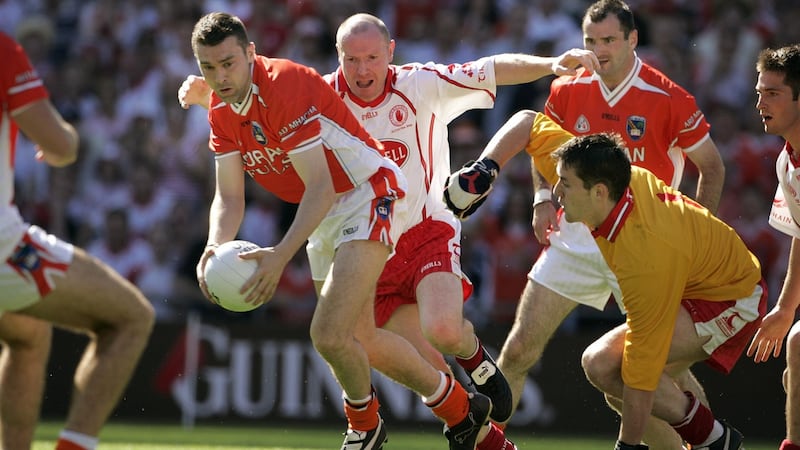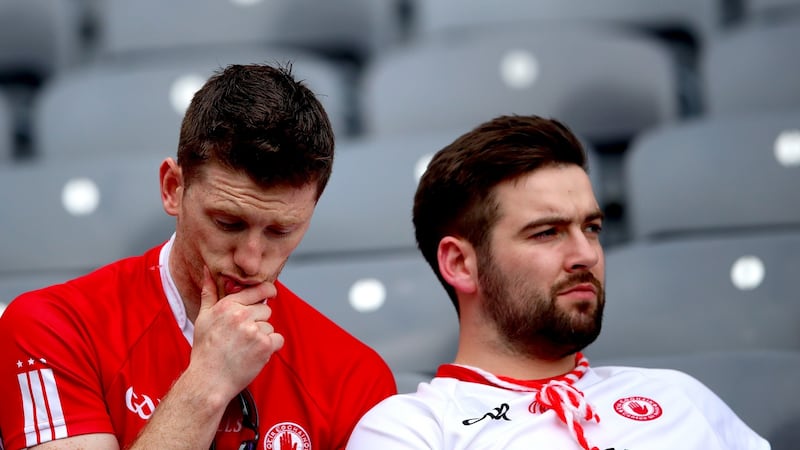The back roads around Clones will take some battering on this particular Ulster final day.
The tumbledown border town is a knotted ball of a wool when it comes to match-day traffic at the best of times but with all the cars and buses coming down from Donegal and Fermanagh, the main road out from Monaghan town will be all but obsolete as the boreens leading from Rosslea and Lisnaskea take the strain. It’ll be like trying to fill a barrel of beer through a handful of straws.
That the football is unlikely to be any more free-flowing is taken as read and certainly not held up as any particular cause for complaint.
Fermanagh have made it to only their sixth ever Ulster final, an immense achievement for Rory Gallagher in his first season and vindication for a group of players who got rid of Pete McGrath over the winter with very little popular backing in the county. They owe nobody a thing, least of all an entertaining game.
The band will play, the sun will blaze, the anthem will be impeccably observed. The tea will go for sterling or euro, whichever you have handy. The grandees of Ulster football will be in the good seats above the tunnel, greeting all comers as they stop for a word and lapping up a day they did as much as anyone to create.
There’s nothing like an Ulster final and these generations of football people in the north deserve to enjoy every inch of something that is palpably and uniquely theirs.
When all is said and won, however, there are wider questions to face. The back end of this decade has been a wasteland for Ulster teams outside the province. No All-Ireland since 2012, no finalist since 2014, no wins for anyone against a non-Ulster Division One team since Donegal beat Dublin in that shock semi-final win four years ago.
In the past three seasons, Ulster counties have played championship games against 22 Division One or Division Two teams from outside the province – they’ve won eight and lost 14.
The stereotypical view of Ulster teams down the years was that they were generally hard to beat. Not recently, they aren’t. In 2017, eight of the nine Ulster counties lost a championship game by at least eight points.
The four Ulster teams that made it to Croke Park had their summers ended by an average defeat of 12. Cavan, Down, Derry and Antrim have already gone down by eight or more in 2018 and we’re only up to the third weekend of June. The old certainties are gone.
“I thought Tyrone were really starting to build last year,” says Benny Coulter. “It seemed that they had a lot of young boys coming through. But then Dublin annihilated them last year and now Monaghan have beaten them this year before getting beaten themselves by Fermanagh. The standard has definitely dropped.
“I can see this Donegal team coming through in the next couple of years because they’re young and they’ve all won minor and under-21 Ulster championships. They look a real strong team and they would be my team in Ulster for the future. But the standard has definitely dropped from where it used to be.”
Became favourites
In 1995, Down came into the championship as All-Ireland holders and were gone by the middle of May. In beating them, Donegal instantly became favourites for Sam Maguire, until they lost next day out to Monaghan. Derry were immediately installed as favourites for the All-Ireland but got mugged by 13-man Tyrone. The year ended with Peter Canavan’s heroics against Dublin in the All-Ireland final and Tyrone robbed of a replay by a dodgy refereeing call. Across the span of the summer, four Ulster teams were legitimate All-Ireland contenders.
You don’t even need to go back that far. In 2003, Armagh, Tyrone and Donegal were all in the All-Ireland semi-finals, the only time three teams from one province have ever been in the last four together. Tyrone and Armagh put together a run of four All-Irelands in eight years at a time when Kerry had probably the second best team in its history on the go.

. Just over a decade later, it feels like a staggering show of strength and confidence in the game in the province. Such a move is unimaginable these days.
In 2017, Tyrone were by a distance the best team in Ulster and still they were undressed by Dublin in Croke Park. The three other Ulster Division One teams last year – Monaghan, Donegal and Cavan – all exited the summer meekly, Monaghan and Donegal to hammerings by Dublin and Galway, Cavan after coughing up a six-point lead at home to Tipperary.
“In terms of competing with the big guns,” says Brendan Devenney, “I think it goes back to the fact that the likes of Tyrone and Armagh changed the game for all the big teams from elsewhere to have to step up. They learned from playing Tyrone and Armagh – and later Donegal – and they became tougher and more streetwise and more tactically astute.
“Counties like Dublin and Kerry and Mayo would always have had players coming through regardless because the one thing you can say for those counties is that football is huge in them. They are always going to produce footballers because there is a love of football there and they are big counties. So once they got to grips with the sort of stuff the northern counties were bringing to the game, it tilted back in their direction.”
Hanging over all conversations, of course, is the endless culture war over the style of football played in the province. For the most part, all teams started from a base of packed defences and look to play off turnover ball. There are exceptions and everyone has their own variations but for the most part, that is what Ulster football is in 2018.
When people get into catfights about blanket defences, it often feels like they’re arguing the wrong thing. Droning on about aesthetics and tradition is ultimately pointless. First and last, it should be about whether you can win playing this way. Increasingly, the evidence is screaming to the contrary.
Monaghan have been a Division One team on and off since 2010, winning two Ulster titles and losing two further Ulster finals. But their record outside the province has been dismal. They’ve won four of 12 games outside the Ulster championship since 2010, losing to Offaly, Kildare, Laois, Longford, Tyrone (twice) and Dublin (twice). Their qualifier victories have come against Kildare in 2014 and Wexford, Carlow and Down last year.
Massed defence
Since Donegal won their All-Ireland in 2012, the game has gone through a number of subtle rule changes, each of them nipping its own little swatch off the usefulness of setting up with a massed defence as a first principle.
The black card has its issues but it has generally erased the body check on give-and-go runners. The introduction of the mark has led to more competition for kick-outs. Forcing goalkeepers pass the 20-metre line with kick-outs gives teams more incentive to push higher up the pitch.
The upshot is that there is a clear ceiling on what can be achieved by sitting in, defending your 45 and leaving one or two forwards in the opposition half. Sitting deep and counterattacking off turnovers evidently works for Monaghan and a few others in the league and in Ulster but not so much when they go further afield.

“Donegal were playing Dublin in 2016 in the quarter-final,” says Devenney, “and I was in the gantry doing a bit of co-commentary. And I was nearly about to stand up and shout, ‘For f**k’s sake! What the f**k are we at?’ All the months and months of training and preparation, how can it be that there isn’t a signal somewhere along the way that says, ‘Right, full-court press here – the championship is over in five minutes if we don’t come out and go at them.’
“Once Kerry beat us in the 2014 final, once they worked out that the way to defeat that sort of gameplan is to mirror it and be patient and get your best players into shooting positions, that should have been the end of it. Kerry had only two weeks of preparation, remember – because they had to go to a replay against Mayo. Two weeks was all it took them to switch to a game plan that would beat a blanket defence team. Ulster teams should have moved on to developing it to the next phase but instead, here we are four years later and it’s still the dominant style of play in Ulster.”
Coulter too has had his days of sadly shaking his head at the futility of it all.
“This year in the Ulster championship, Antrim came to Down. Down were no great shakes but Antrim still threw everybody behind the ball and gave up on kick-outs. I was sitting there going, ‘Jesus, would you ever go and try and win the game?’ They ended up still getting beaten by seven points, even with playing 14 men behind the ball. They didn’t press up on a single kick-out.
“Their manager must have been sitting watching Down playing against Donegal and getting wiped by them and thinking, ‘Jesus, what were we at? Why didn’t we think we couldn’t have a go against these guys?’ What’s the point? I’m not saying they’d beat them having a go but if you’re going to get beaten by that much with a blanket defence, what’s it for?
“Down have real good attacking footballers and we played with 12 men behind the ball this year in the league and still got relegated. Then we did it against Donegal and got a tanking. I just think it’s getting a wee bit outdated.”
Fermanagh are in the Ulster final, of course, Monaghan having paid the price for leaving them with a puncher’s chance in the semi-final. Gallagher has drilled them into an expert blanket defence and nobody should cock a snook in their direction for it. They are, famously, one of only two counties who have never won a provincial title and should be roundly applauded for using whatever means necessary to get to within 70 minutes of one.
In the wider world, however, the province needs to start working its way out of the death clench all these teams have on each other. It’s an article of faith that what will win you an Ulster title won’t be good enough to win you an All-Ireland. For the good of everyone in Clones tomorrow and around the province, that has to change.
“That’s why I’m encouraged by what I’ve seen from Donegal this year,” says Devenney. “Okay, they’ve probably been lucky enough with the run they’ve got to the Ulster final and Fermanagh will put it up to them on Sunday. But they’re trying to play with a bit more expansion and genuinely, I believe that’s what Ulster needs. It needs a team to win the Ulster championship coming out of its shell and playing the sort of football that can win in Croke Park.
“Otherwise, everybody will just keep doing what they’re doing and Ulster teams will keep doing nothing in the rest of the championship. At least this Donegal team looks like it is going out to try and win matches. If you’re going out trying not to lose and hoping for the win in the last 10 minutes, the better teams in Croke Park will just laugh at you.”
For Ulster football, that would be the worst fate of all.




















